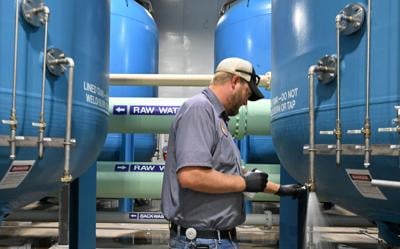Contamination caused by forever chemicals in the water and soil in the Security-Widefield area has been well mitigated after multimillion dollar efforts, according to an analysis by a health agency of the U.S. Department of Health and Human Services.
The “forever chemicals” were caused by the historic use of firefighting foam at Peterson Space Force Base and analyzed by the Agency for Toxic Substances and Disease Registry. Mitigation efforts have come from the Air Force along with state and local authorities.
The ATSDR, a federal public agency of the Health and Human Services, issued its final report Thursday on 10 sites across the country it examined for PFAS contamination, including the Security-Widefield area near Peterson.
The report summarizes levels of the chemicals found in blood and urine of residents living in places known to have elevated PFAS in drinking water near former or current military bases.
The study compared the results to national PFAS levels and categorized the results according to age, race/ethnicity, sex, number of years living in the community, drinking water consumption patterns and other exposure parameters.
The number tested: 2,384 residents from 1,212 households in the 10 areas.
Only two of the 176 drinking water samples collected measured above ATSDR’s screening value for PFOS in drinking water, and all were below the EPA’s 2016 health advisory and state public health guidelines for PFAS in drinking water.
In June, the Environmental Protection Agency issued a health advisory drastically lowering the agency’s recommendations on safe limits for drinking water.
The new lifetime health advisory level recommendations are 0.004 parts per trillion for PFOA and 0.02 ppt for PFOS, the two most prevalent types of PFAS. This is a reduction from the agency’s 2016 recommendation for safe maximum lifetime perfluoroalkyl and polyfluoroalkyl substances (PFAS) concentrations of 70 parts per trillion.
An EPA fact sheet described the new health advisory levels as “below the levels at which analytical methods can measure PFOA and PFOS.”
The report also presents results from household dust and tap water samples and explores relationships between blood results and the environmental sampling data.
Of the six kinds of PFAS chemicals evaluated, the most common, PFOS and PFOA, showed higher concentrations in the evaluated communities than the national averages.
For PFOS, the Security-Widefield community came in seventh worst in the U.S. with 5.2 parts per billion against the national average of 4.3 ppb.
For PFOA, the community was fifth worst with 1.8 ppb against the national average of 1.4 ppb.
Airway Heights, Wash., residents came in at the top of the ATSDR list for PFOS and PFOA at 39.1 ppb against the national average of 1.1 ppb, and at 8.9 ppb against the national average of 4.3 ppb.
Despite millions of dollars spent on mitigation, some Security-Widefield residents remain fearful.
“I was definitely concerned about it then, and I’m still concerned about it now,” Security resident Blaine Magee said in a Gazette story this summer.
Results of recent studies, combined with new EPA health advisories and expected industry regulations, mean other Colorado communities likely will need to remediate in upcoming years.
Meanwhile, Roy Heald, general manager of Security Water and Sanitation Districts, told The Gazette in earlier reporting that the area’s drinking water has been deemed safe after wells in the Fountain Valley were shut down and Arkansas River water from Pueblo Reservoir was piped in from the Southern Delivery System.
According to ATSDR, research involving humans suggests that high levels of certain PFAS may lead to increased cholesterol levels, decreased vaccine response in children, changes in liver enzymes, increased risk of high blood pressure or pre-eclampsia in pregnant women, small decreases in infant birth weights, and increased risk of kidney or testicular cancer.
ATSDR emphasizes the word “may” in its report, adding, “At this time, scientists are still learning about the health effects of exposures to mixtures of different PFAS.”
The report emphasizes that community drinking water systems “meet all federal and state guidelines,” and does not recommend community members use alternative sources of water, but that for affected private wells, ATSDR recommends community members continue to use the alternative sources of water or filtration systems provided to them.






 Your Privacy Choices
Your Privacy Choices